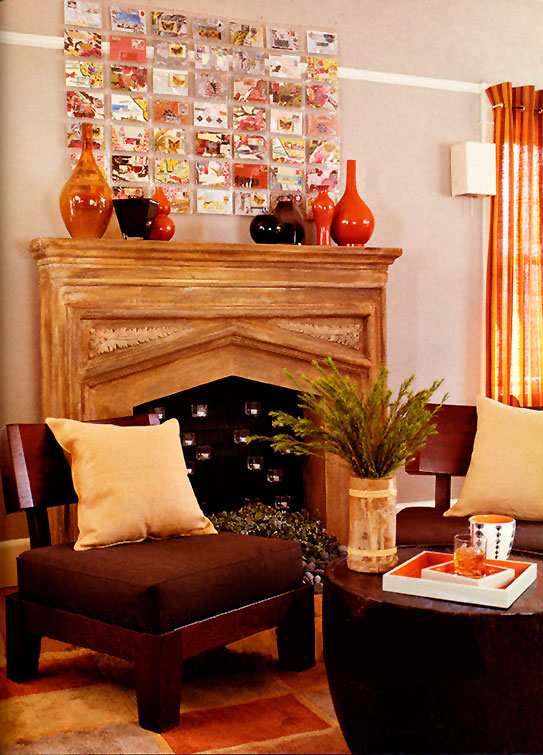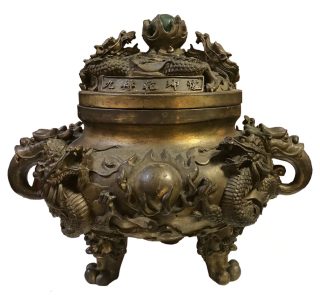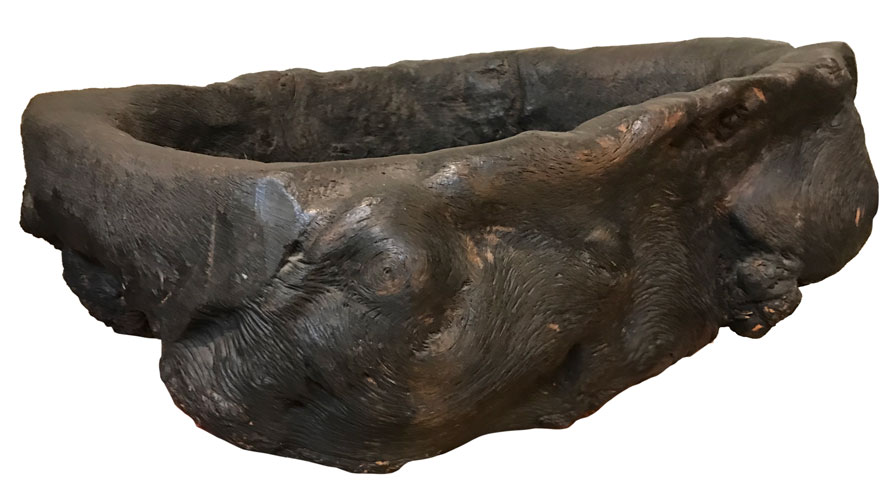Designer: Rob Horby



As seen in San Diego Home & Garden
I have approached the bedroom as if it were Savannah, circa 1800,” says Robert Horby, who grew up visiting 18th-century mansions like Williamsburg and Winterthur, Mount Vernon and Monticello. To bring the look into today’s world, Horby used black finishes on all the teak English colonial furnishings such as nightstands, chests of drawers and East Indies plantation chairs.
Antiques come into play with table lamps and accessories.
The predominante color is the butterscotch suede of the upholstered bed with a lighter shade on the fitted silk cover. Windows are covered with butterscotch sheer silk tab curtains on a black rod. Trim on the bed is red and red pillows and chair cushions provide more bright accents. Original artwork including a map of the world on canvas hanging over the bed, is by local artists.
The bathroom retains its original 1930 aqua and black tile. Horby has added framed historic black-and-white photography and color to the walls.
Designer: Rob Horby

As seen in San Diego Home & Garden


Rob Horby has a passion for all things Asian. So when the interior designer had the opportunity to create a master bedroom at the San Diego Historical Showcase, not surprisingly he headed in an Eastern direction. Horby, whose store Circa a.d. specializes in Asian design, felt Asian-style furnishings would be an ideal match in the Arts and Crafts-stryle home. Before bringing in the cinnabar chests and obis, the designer had to turn the oversize room with a leaky ceiling and peeling paint into a functioning master bedroom. “Replastering the ceiling and repainting the wall was costly, but those were the easy parts,” Horby says. “The nightmare was dealing with a space that was nearly 40 feet long.” To make the space more manageable, he compartmentalized it into three sections with distinct functions: sleeping quarters, a place for sipping morning coffee, and an area for watching television. “I envisioned this as a room where you could close the door and be away from the family, a real adult treat,” he says.
Once the structural and space problems were solved, Horby was ready to show how Asian and contemporary styles can mix. Setting the tone is a platform bed with a tufted suede headboard that neatly straddles the contemporary and Asian words. “Many current designers are using platform beds,” Horby says, “But the platform style also is a longstanding Asian design, with its lowness to the ground similar to that of a futon.”
Flanking the bed and at its end are three sections of a 1910 Japanese tansu chest that were originally placed side by side. “It’s the Asian take on modular,” Horby says. “With their big, deep drawers, these items make great storage pieces, and their clean lines go with anything.” A pair of contemporary chairs from Indonesia and a wood drum-turned-table come together as the ideal setting for reading the paper. Lit candles on a votive rack set in the firebox provide a soft glow. The fireplace surround is fashioned from cast fiberglass intended to mimic the look of old plaster.



Accorning to Horby, th 19th century Chinese Ming-style red armoire he used to concel the television in the entertainment area is a traditional dowry piece. “They are plentiful and an attractive way to hide electronics,” he says. “Despite its age, the simplicity of the piece gives it a very modern feel.” Two matching streamlined chaises upholstered in soft cotton offer laidback seating for watching movies or listening to music.
Throughout the space, color layers on the warmth. Required by the historical society, the Craftsam paletter of greens, taupe, chocolate brown, and a persimmon played right into the designer’s Asian sensibilities.
Broad strokes of bold color appear in the custom bedding, Thai-silk pillows, striped draperies, and glazed pottery. “I wanted to show people how good orange can look,” Horby says, “It’s a bright, happy color that brings energy and life into a room.”
Adding to the Eastern spirit are Oriental textiles used as decoration: A traditional obi graces one wall, and a pair of folded obis is draped on the nightstands.
“Because people haven’t had a great deal of exposure to Asian design, they tend to be a little afraid of it,” Horby says. “But I think this room shows how practical this style is and how well it works in any setting.”
Designer: Rob Horby


The Great Room is divided into entry, fireplace seating and game table and conversation area. Rob Horby chose Sailcloth, a neutral wall color, as a background to his design.
Growing up in Pennsylvania, Horby visited the workshop of legendary furniture maker George Nakashima. Horby furnished the living room with his idea of Nakashima rustic stylishness focusing on the beauty of natural wood both dark and light. Furnishings include two deep plantation benches, a slab coffee table and four French-design mid-century easy chairs. Upholstery is in rough-textured natural-linen fabrics. A Japanese tansu serves as the bar.
Accessories include raku pottery and a collection of folk art. Flooring is sisal, sea grass and a retro classic shag rug, while lighting emulates rice-paper designs by Isamu Noguchi.
Highlights Include
Designer: Rob Horby


The living room of Quarterers B, with original fireplace and mantel, has been turned into an Art Deco era private club room for entertaining. Rob Horby, of Circa a.d., has used the taupe and beige of the color palette together with a large dose of black and chrome and accents of green.
Instead of the obvious sofa, four large suede club chairs furnish the primary seating in front of the fireplace. An oversize leather ottoman, with silver nailhead trim, is in the midst of the chairs to hold a tray of drinks, serve as extra seating or be a place to prop your feet. More extra seats are in the form of woven leather cubes stowed under a table.
Over the mantel, where painting or mirror used to hang, is a state-of-the-art flat screen television for punching up the latest DVDs.
Coctail shakers, martinin glasses and curved Deco dark-wood bar add to the Cole Porter ambience. A sideboard with chrome shelving holds extra glasses and dishes for snacks. A live-green silk lotus floor lamp is just one of several green accents with an Asian origin.

Designer: Rob Horby
The original mahogany wood paneling, built-in cabinets and glass-door bookcases of this room give designer Rob Horby the basis of his design plan. The most important piece he adds to the room is a grand Ming-style antique rosewood scholar’s desk. The desk appears to be floating above the cloud-design panels below. Two Chinese Ming-style chairs are paired with the desk. These reflect the Craftsman period interest in Asian design.
The soften the formal, serious nature of the room, Horby adds several suede-covered slipper chairs in a color he calls orange passion for a comfortable seating area. Antique capiz shell window panels cover the windows and two contemporary capiz shell chandeliers provide light for the room. Antique and contemporary Asian pottery and a collection of Arts and Crafts pottery are arranged in the bookshelves with coral and seashells. The orange of the palette is tempered with red touches to blend with the dark mahogany of the wood.
Highlights:

Located between the trade routes of the Middle East, India and China, Indonesia has experienced millennia of varying cultural and religious influences which have produced an unparalleled artistic heritage. Indonesia is noted for its Dutch Colonial furniture, as well as its native styles which vary from the primitive Irian Jaya to the ornate Hindu carvings of the Balinese.
Circa not only imports antique pieces from Indonesia, but also has designed its own exclusive collections reminiscent of English and Dutch Colonial styles. Each piece is hand-crafted from recycled teak. The owners of Circa have traveled extensively in Indonesia in order to find the best quality manufacturing for their designs. You’ll find that their Indonesian collections will accentuate any decor.

Japan is a technological giant and has a major impact on world design. From computers to ceramics, Americans are daily exposed to Japanese culture and influence; and the design principles used today are rooted in the past. Upon examining a piece of Japanese antique furniture, one readily sees the uncanny mix of function and aesthetics which is pervasive in their design production.. Their fine craftsmanship; their elegant use of proportion and scale; their utilization of rare Asian woods and intricate metal work combine to make their pieces prized by connoisseurs throughout the world.
Japanese furniture can be summed up in one word…tansu… which means chest. Tansus are characterized by their use. For example, a Cho Tansu or tea chest would be used for the storage of tea and the accouterments which complement Japan’s famous tea ceremonies. A favorite among Westerners is the Kaidon Tansu or step chest. These step-shaped pieces were once used as stairs. They epitomize the Japanese concept of functionality. The tansus’ clean, sophisticated lines and practical usage make them a prefect fit for contemporary interiors.

Korean furniture is often both overlooked and under appreciated. The amazing economic development of South Korea has opened the door to collectors and designers who are looking for something different and elegant. Traditional Korean furniture possesses a simple and unique beauty. The grain of the wood, the hewn surfaces and symbolic hardware are the essence of the Korean aesthetic.
Korean culture is based on Taoism, and is reflected in the furniture’s symmetry, solid construction and practical function. Korean furniture design revolves around different kinds of chests and small tables. The most common antique chest is the Bandaji Chest which is rectangular in shape and has a front door which folds down; its primary use being that of storing blankets and bedding. These Bandaji are most often adorned with a variety of metal work which, ranging from the sublimely delicate to the spectacular, reflect the region where it was made, as well as the wealth of its owner.
Because Korea is a small country possessing great wealth, its antique pieces are at a premium. Korean reproductions are an excellent alternative to more expensive original pieces and function well in Western homes. Exotic woods such as persimmon, elm, and paulownia give Korean furniture its unique and lasting quality. Circa a.d. is proud of its fine collection of antique and reproduction Korean furnishings, which include wardrobes, chests, wedding trunks, meal tables, buffets, and alter tables.

Circa a.d. has a rare and wonderful collection of antique Tibetan furniture. For centuries Tibet was isolated from the world, but most recently has been embraced, both politically and artistically, by the West. This embrace has unveiled a exceptionally rich and beautiful culture which, based on the Buddhist philosophy, has produced a unique art form hallmarked by superb craftsmanship, brilliant color and deep symbolic meaning.
While Tibetan pieces and artifacts have arrived on the design scene, the beautiful chest and cabinets, which are the gemstones of Tibetan productivity, won’t be around for long. Tibet is a vast region, but has a proportionately small population which, as devotees of the simplicity of Buddhism, have proclaimed a decided and limited need for material goods such as furniture.
Collectors around the world have recognized the scarcity and beauty of these antique pieces and are snapping them up at every opportunity. You see, unlike the Chinese, the Tibetans do not have the infrastructure to continue producing these pieces; making the supply of Tibetan furniture even more limited and… oh so rare!

Some 20 years ago, antiques began to trickle onto world consumer markets as China began to unveil its vast resources to the West. In the 80’s, as the political climate proved more favorable, the floodgates opened and Chinese antique furniture became readily available.
Recently, however, because of China’s enjoyment of favored nation status and its rush to trade, the tide has turned and consumers are finding that the supplies of good pieces have begun to dwindle and that prices have been on the rise. Still, even with the economic crisis in Asia, the remainder of available Chinese furniture continues to break records at Christie’s and Sotheby’s … proving that Chinese furniture maintains its desirability while ever increasing in value.
Generally, when Westerners think of Chinese furniture, they picture it as being massive, dark, and heavily carved. However, the reality is that good Chinese pieces are characterized by simple form, cubic proportions, graceful lines and finely grained wood; sometimes stylized with rich, lacquered finishes which lend themselves even more beautifully to Western design.
Another aspect of Chinese furniture is expert craftsmanship. Simply put: The Chinese are master cabinetmakers. Not since the inscrutable architecture of ancient Egypt has there been so innovative an employment of puzzle-like joints which, by the way, necessitate the use of neither glue nor nails. A fact which made Chinese furniture the envy of the 20th Century arts and crafts movement.
A blurb about your products and how you simply click Inquire if you’re interested in a particular item


